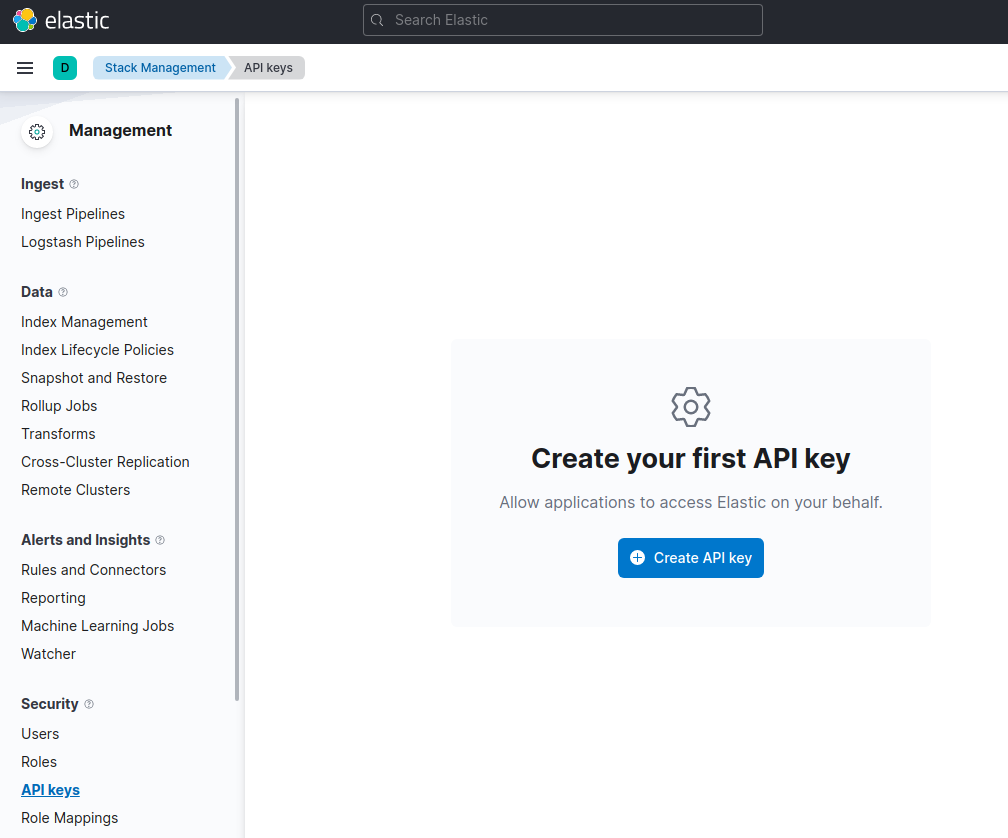Getting started
editGetting started
editThis page guides you through the installation process of the Go client, shows you how to instantiate the client, and how to perform basic Elasticsearch operations with it. You can use the client with either a low-level API or a fully typed API. This getting started shows you examples of both APIs.
Requirements
editGo version 1.13+
Installation
editTo install the latest version of the client, run the following command:
go get github.com/elastic/go-elasticsearch/v8@latest
Refer to the Installation page to learn more.
Connecting
editYou can connect to the Elastic Cloud using an API key and the Elasticsearch endpoint for the low level API:
client, err := elasticsearch.NewClient(elasticsearch.Config{
CloudID: "<CloudID>",
APIKey: "<ApiKey>",
})
This is the same for the fully-typed API:
typedClient, err := elasticsearch.NewTypedClient(elasticsearch.Config{
CloudID: "<CloudID>",
APIKey: "<ApiKey>",
})
Your Elasticsearch endpoint can be found on the My deployment page of your deployment:

You can generate an API key on the Management page under Security.

For other connection options, refer to the Connecting section.
Operations
editTime to use Elasticsearch! This section walks you through the basic, and most important, operations of Elasticsearch. For more operations and more advanced examples, refer to the Examples page.
Creating an index
editThis is how you create the my_index index with the low level API:
client.Indices.Create("my_index")
This is how you create the my_index index with the fully-typed API:
typedClient.Indices.Create("my_index").Do(context.TODO())
Indexing documents
editThis is a simple way of indexing a document by using the low-level API:
document := struct {
Name string `json:"name"`
}{
"go-elasticsearch",
}
data, _ := json.Marshal(document)
client.Index("my_index", bytes.NewReader(data))
The same operation by using the fully-typed API:
document := struct {
Name string `json:"name"`
}{
"go-elasticsearch",
}
typedClient.Index("my_index").
Id("1").
Request(document).
Do(context.TODO())
Getting documents
editYou can get documents by using the following code with the low-level API:
client.Get("my_index", "id")
This is how you can get documents by using the fully-typed API:
typedClient.Get("my_index", "id").Do(context.TODO())
Searching documents
editThis is how you can create a single match query with the low-level API:
query := `{ query: { match_all: {} } }`
client.Search(
client.Search.WithIndex("my_index"),
client.Search.WithBody(strings.NewReader(query)),
)
You can perform a single match query with the fully-typed API, too:
typedClient.Search().
Index("my_index").
Request(&search.Request{
Query: &types.Query{MatchAll: &types.MatchAllQuery{}},
}).
Do(context.TODO())
Updating documents
editThis is how you can update a document, for example to add a new field, by using the low-level API:
client.Update("my_index", "id", strings.NewReader(`{doc: { language: "Go" }}`))
And this is how you can update a document with the fully-typed API:
typedClient.Update("my_index", "id").
Request(&update.Request{
Doc: json.RawMessage(`{ language: "Go" }`),
}).Do(context.TODO())
Deleting documents
editLow-level API:
client.Delete("my_index", "id")
Fully-typed API:
typedClient.Delete("my_index", "id").Do(context.TODO())
Deleting an index
editLow-level API:
client.Indices.Delete([]string{"my_index"})
Fully-typed API:
typedClient.Indices.Delete("my_index").Do(context.TODO())
Further reading
edit- Learn more about the Typed API, a strongly typed Golang API for Elasticsearch.